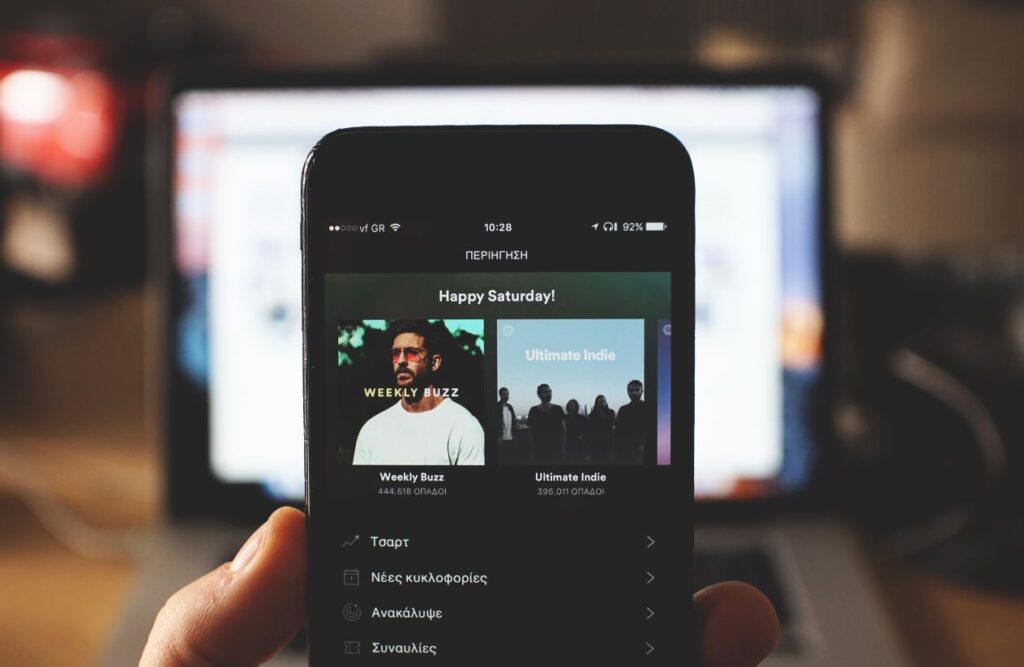Looking for ways maximizing your music’s reach? You’re in the right place, continue reading to learn more!
Understanding Spotify’s Playlist Ecosystem

Spotify’s playlist ecosystem is a multifaceted environment where artists, tracks, and listeners interact in dynamic ways.
Understanding this ecosystem is crucial for musicians aiming to expand their audience and increase their music’s visibility.
As an experienced musician with a history of performing at various events, leveraging this system effectively can lead to significant career benefits.
The Types of Playlists on Spotify
Spotify categorizes its playlists into three main types: Spotify-curated playlists, algorithmically generated playlists, and user-created playlists.
Spotify-curated playlists are crafted by the platform’s editorial team and feature a wide range of themes, moods, and genres. Algorithmically generated playlists, such as “Discover Weekly” and “Release Radar,” use listener data to create personalized listening experiences.
Lastly, user-created playlists are made by Spotify users, allowing anyone to showcase their favorite tracks. Each type offers unique opportunities for artists to get their music heard by new and broader audiences.
How to Get Your Music on Spotify Playlists
Getting your music featured on any of these playlists requires different strategies. For Spotify-curated playlists, it’s important to submit your unreleased music through the Spotify for Artists platform, giving Spotify’s editorial team a chance to review your track.
Building a strong presence on the platform and engaging with your audience can also improve your chances. For algorithmic playlists, ensure your music is properly tagged with relevant metadata to increase its chance of being picked up for personalized playlists.
Engaging actively with your existing fanbase, encouraging them to save, share, and frequently listen to your tracks, can influence these algorithms in your favor.
Meanwhile, reaching out to creators of user-generated playlists and networking within communities can help get your tracks added to these lists.
Leveraging Spotify’s Playlist Ecosystem for Growth
As you become more familiar with Spotify’s playlist ecosystem, consider the broader implications of playlist placements for your music career.
Being featured on a major Spotify playlist can lead to significant increases in streams and follower growth.
It’s also crucial for driving engagement during the release window of new music. Strategically releasing singles, EPs, or albums to align with the discovery cycles of Spotify’s algorithmic and curated playlists can maximize visibility.
Additionally, engaging with your listeners through Spotify’s social features and integrating your Spotify artist profile with your social media and official website can further amplify your presence within the ecosystem.
By understanding and strategically engaging with Spotify’s diverse playlist ecosystem, you can enhance your music’s discoverability and cultivate a larger, more engaged audience.
This approach, coupled with your experience performing at events, can catalyze the next stage of your music career.
Keys to Unlocking Spotify’s Algorithmic Playlists

As an experienced musician who performs at many events, you understand the power of reaching new audiences.
Spotify’s algorithmic playlists, such as Discover Weekly, Release Radar, and Daily Mix, offer a unique opportunity to do just that.
However, unlocking these playlists requires a deep understanding of how Spotify’s algorithms work and what they prioritize. Here are some key strategies to help you master Spotify’s algorithmic playlists and expand your reach.
Optimize Your Profile and Music for Discovery
Your first step is to ensure that your Spotify artist profile and tracks are optimized for discovery.
This includes having high-quality track uploads, engaging song descriptions, and an active, up-to-date profile. Utilize Spotify for Artists to upload compelling images, craft your artist bio, and share your upcoming shows.
These elements not only enhance your profile’s attractiveness but also provide valuable metadata that feeds into Spotify’s algorithms, helping them understand what kind of listeners might enjoy your music.
Leverage Release Momentum
Spotify’s algorithms favor new releases, especially within the first few weeks of release. Plan your release strategy to maximize listener engagement during this critical period.
Engaging with your fans through social media, email newsletters, and your website can drive initial streams and saves, which are strong signals to Spotify that your new track deserves attention.
Additionally, consider releasing singles leading up to an EP or album launch to continuously feed the algorithm fresh content, thereby keeping your audience engaged and attracting new listeners.
Cultivate Listener Engagement
Engagement goes beyond just listening; it encompasses saves, follows, pre-saves, and shares. Spotify’s algorithms take note of how listeners interact with your music.
Encourage your audience to not just stream your songs but to save them to their personal playlists, follow your artist profile, and share your tracks on social media.
The more engagement your tracks receive, the more likely Spotify’s algorithms are to feature them in algorithmic playlists, exposing your music to potential fans who have shown interest in similar genres or artists.
By focusing on these key areas, you, as an experienced live performer, can further leverage Spotify’s platform to reach new fans globally.
This not only enhances your online presence but also complements your efforts on the live music scene, creating a holistic approach to growing your audience.
Crafting Your Pitch for Spotify’s Editorial Playlists

Crafting an appealing pitch to get your music featured on Spotify’s editorial playlists is a pivotal step in expanding your audience.
As an experienced musician who has performed at numerous events, you already understand the importance of connecting with your audience.
This experience provides a unique advantage in creating a compelling pitch. Here are some strategies to help you leverage your live performance experience in your pitch.
Highlight Your Live Performance Success
Begin your pitch by emphasizing your success and experience in live performances. Mention the number of events you’ve played, notable venues, and any festivals or significant shows where you’ve made an appearance.
This information illustrates your active engagement in the music scene and suggests a built-in audience for your music.
Spotify’s editorial team looks for artists who are not only talented but also have a growing fanbase that can be leveraged to increase playlist engagement.
Showcase Your Audience Engagement
Include details about your audience engagement both online and offline. Share insights into how your performances resonate with fans, including any notable crowd sizes, fan interactions, or memorable moments from your shows.
If you have a strong social media following or a notable online presence that complements your live performances, mention this as well.
Demonstrating a high level of engagement suggests that your tracks will perform well on their playlists by keeping listeners engaged and interested.
Connect Your Music to Your Performance Experience
Finally, make a clear connection between your music and your live performance experience. Explain how your tracks capture the energy, emotion, or unique aspects of your live shows.
If your music incorporates elements that reflect the vibe of your performances or if certain songs have proven particularly popular with live audiences, highlight these points.
This approach not only showcases the appeal of your music but also suggests its potential success on Spotify’s editorial playlists.
By focusing on your live performance success, audience engagement, and the connection between your music and your live shows, your pitch can stand out to Spotify’s editorial team.
Remember, the goal is to show not just the quality of your music but also its potential to attract and retain listeners on their platform.
Leverage Your Data: Insights for Spotify Success

Understanding the vast landscape of Spotify and its algorithm can feel like navigating through a dense forest without a map.
However, with the right analytics tools provided by Spotify for Artists, you can turn data into your compass, guiding your music career to new heights.
This powerful platform gives artists access to a trove of insights that, when leveraged correctly, can exponentially increase their visibility and audience on Spotify.
Analyze Your Audience
The first step in utilizing your data for Spotify’s success is understanding who is listening to your music.
Spotify for Artists offers detailed analytics on your listeners’ demographics, locations, and how they found your music.
As an experienced musician who performs at many events, this information is gold. It allows you to tailor your marketing strategies, target your audience more effectively on social media, and even plan tour locations based on where your listeners are concentrated.
By analyzing these trends over time, you can also spot growth areas or niches that you might not have considered targeting before.
Optimize Your Releases
Data provides invaluable insights into what works and what doesn’t when it comes to your music releases.
The release radar and discovering music features on Spotify use algorithms to push new tracks to listeners.
By analyzing which of your songs have higher engagement rates, saves, and are added to playlists, you can start to understand what captivates your audience. Use this information to decide the direction of future projects or even to rework existing tracks.
Pay special attention to the types of playlists where your songs are being added, whether they be algorithmic, editorial, or user-generated, as this can inform your promotional strategies and pitch approaches.
Engage Through Playlists
Playlists are the beating heart of Spotify, and getting your tracks featured can significantly boost your streams and listener base.
Your data can tell you a lot about the playlists you’re already on and help you identify new ones to target.
Look at the playlists that feature similar artists or genres and reach out to their curators with a personalized pitch, highlighting why your music would be a perfect fit based on the data-backed insights you’ve gathered.
Additionally, consider creating and promoting your own playlists that feature your music alongside other artists you admire or collaborate with, driving mutual growth.
By turning your Spotify data into actionable insights, you take control of your music career’s trajectory on the platform.
Remember, the key to leveraging your data for Spotify’s success is continuous learning and adaptation. Stay curious, keep analyzing, and let your data drive your creative and promotional strategies forward.
Beyond Playlists: Amplifying Your Spotify Presence

While playlists are a fantastic tool for increasing visibility on Spotify, several additional strategies can help you amplify your presence on the platform and engage with a wider audience.
Let’s explore some of the key tactics beyond playlist placements that you, as an experienced musician performing at numerous events, can leverage to maximize your reach and connect with more fans on Spotify.
Engage with Your Fans through Spotify for Artists
Spotify for Artists is an essential tool for any musician looking to expand their presence.
It allows you to update your profile, including your bio, photos, and social links, which can make your page more attractive to both existing and potential fans.
You can also use this platform to share your upcoming events and performances, making it easier for your fans to keep track of where you’ll be performing live.
Engaging with fans by responding to comments and messages can also boost your visibility and encourage more interactions, leading to increased streams and followers.
Collaborate and Create with Other Artists
Collaboration is a powerful tool for growth on Spotify. By teaming up with other artists, you not only get exposed to their fan base but also create unique content that can attract new listeners.
Consider collaborating on a single, EP, or even just a couple of tracks to release exclusively on Spotify.
These collaborations can then be promoted across your social media channels and during your live events, creating buzz and driving listeners to Spotify to check out the new tunes.
Leverage Spotify Ad Studio
For those looking to invest in their Spotify growth, Spotify Ad Studio offers a way to reach potential fans directly through targeted audio and video ads.
These ads can be customized to play to listeners who have shown interest in similar artists or genres, making them highly effective in reaching a relevant audience.
Although there is a cost involved, the return on investment in terms of new listeners and followers can be significant, especially if you have a new release that you’re promoting alongside your live event performances.
By implementing these strategies alongside securing playlist placements, you can significantly enhance your Spotify presence, reaching new fans and engaging with your audience in a more meaningful way.
Remember, success on Spotify is not just about the numbers but about building a loyal fan base that will support your music career long-term.
Related Content: Indie Musicians (Master Brand Building with Sonicbids Guide)






